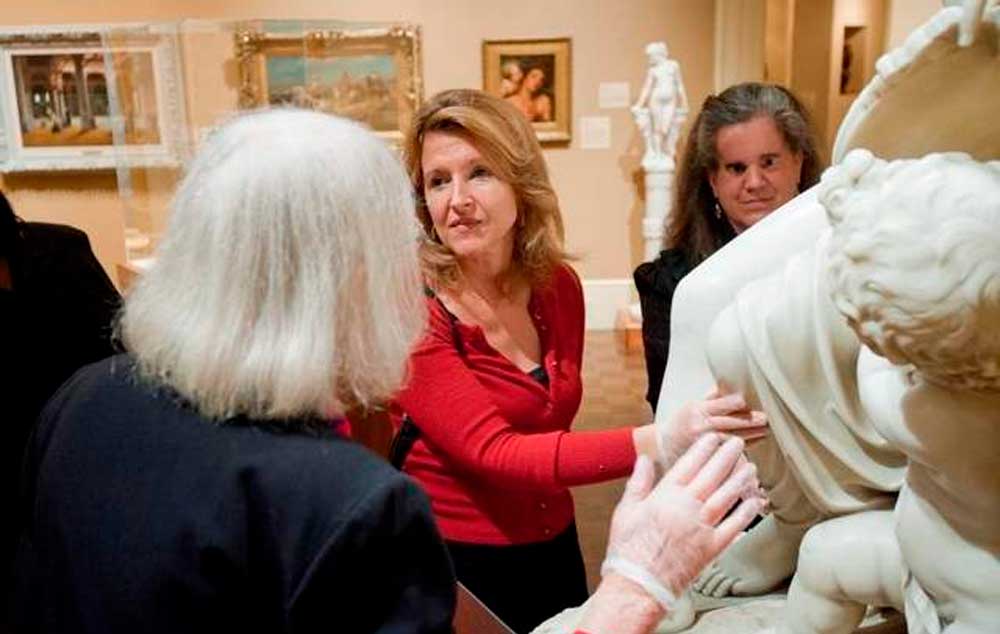
Memorial Art Gallery reaches out to populations with disabilities
Most people who take guided tours at the Memorial Art Gallery are seeking information about the artwork, the artists or the stories behind the pieces’ creation. • But on certain Tuesday afternoons, people with dementia and their care partners are welcomed for tours focused on making connections. The art is used to stimulate memories and conversation. • The MAG also offers guided touch tours of sculptures for people who are blind or have low vision. George Eastman House offers tours narrated in sign language, and Geva Theatre Center will start interpreting some of its shows this fall. • These are some of the ways that cultural organizations are reaching out to populations with disabilities and special needs, and some local groups have become leaders in this field.
On a recent tour for this Meet Me at the MAG program, a group gathers around a Henri Matisse oil painting from 1922-23. Their guide, Christine Carey of Pittsford, asks what they see in the image of a girl wearing a flowered dress, titled Girl with a Tricorne.
“The hat is kind of crazy to put on a pretty lady,” says Leslie DiVerdi, 60, calling it a pirate hat. DiVerdi, whose memory problems forced her to retire early as a chemistry professor at Colorado State University and move in with her mother in Webster, also notices designs on the floor in the painting: “Is it tears?”
The group isn’t sure what to make of a black spot below the dress of the painted girl. It could be a shoe, they say, but the shape isn’t right. Maybe it’s a big bug, one visitor suggests.
Their docent gets a round of laughs by replying, “Maybe that’s why her hands are clenched.”
The program was inspired by a similar Meet Me at MoMA effort that began in 2006 at The Museum of Modern Art in New York City. MoMA also offers art-making studio programs for such visitors in its classroom spaces and off-site at care organizations; the Rochester gallery is looking into offering art classes on-site for people with dementia.
Meet Me at the MAG started three years ago in Rochester, thanks to donations from one family and then a second family, to cover costs. The docents who guide the visitors are volunteers trained by both the Alzheimer’s Association and the gallery.
“Our mission is to connect people and art,” says Susan Daiss, McPherson director of education at the MAG. The tours for people affected by dementia are intended to enhance their quality of life by providing a beautiful setting and the chance to react to the artwork at a slow, thoughtful pace — to match the speed at which people are likely processing the experience. Another plus: Looking at something together is a uniting experience.
The docents guiding the guests with memory problems have to be ready for anything, so they have several docents along to help. Sometimes visitors wander and need to be redirected. They may need reminders that sculptures and paintings can’t be stroked. People who get agitated or anxious at one scene are calmly walked over to another piece of art.
Some of the guests’ comments can be hard to follow, but the guides try to respond positively to everything.
On the tours for the blind, the participants, wearing gloves, use their hands to see the size, shape and texture of the object, says Daiss, who leads the touch tours.
“It’s delicious because you know nobody else is allowed to touch at an art museum,” says Daiss, who also oversees the MAG’s accessibility programs.
Ann Parsons of Brighton, who has been blind since birth, says such tours are neat “because I’m able to experience art my way, instead of experiencing it the way other people think I should.” It’s much different from a companion describing the object. “When I touch art objects, I connect them with experiences I’ve had, as opposed to getting another person’s life view.”
The gallery also provides recorded audio descriptions for some of the paintings, accessible by cellphone, giving blind visitors a way to visualize the artwork and draw their own interpretations of it.
“It’s a way of opening opportunities you wouldn’t have otherwise,” says Rene Latorre, who took part in the tour.
Back on the Meet Me at the MAG tour, Carey gathers her tour group on a bench and portable chairs in front of a Japanese paneled screen from the mid-1600s. Sections show waves, flowers and mountains. “If you could walk into this scene, where would you prefer to be?” she asks.
One man with dementia replies that water isn’t a good thing for paintings — depending on your plumbing. Later, when his wife mentions how nice everyone on the tour was, he says, “The farther you go west, the nicer the people are.”
David Midland, president and CEO of the local Alzheimer’s Association, applauds several organizations that welcome this population. The Rochester Philharmonic Orchestra opens its rehearsals to people with dementia and their caregivers. William and Sheila Konar have donated blocks of tickets several times a year for people affected by dementia to attend regular performances at Geva, believing that the arts can improve their quality of life. Since 2009, more than 450 tickets have been given to patients and caregivers.
The art gallery’s special tours are done at a time when the building is closed to the public, which provides a calm setting without distractions.
Maureen Basil of Perinton, one of the docents on the recent tour, says the guides tend to pick a theme for each tour and then choose well-lit, large pieces of art that could be springboards for conversation. In addition to the tours for community residents with dementia, the MAG also hosts groups of people with dementia from Cherry Ridge of St. Ann’s Community and Episcopal SeniorLife Communities at Brentland Woods, who attend with staff or volunteers.
Basil recalls that one piece of art prompted a person with dementia to talk about growing up on a farm, which the person’s elder-care staff hadn’t known. That detail provided the staff with a new way to connect, says Basil: “They’re very thankful to learn something more.”
On another tour, Daiss says, an elderly woman connected with an image of 19th-century women washing clothes by a river and spreading them out on the grass to dry. She remembered putting clothes out to dry as a child.
The recent tour stops at a newly refurbished Flemish tapestry woven from 1565 to 1575 that shows a busy scene of animals in and around a garden arbor.
Betty Bell of Rochester comments that she sees “a lot of animals.” Carey asks, “Do you know what animals they are?”
“No, I don’t,” says Bell. Others point out an owl, multiple fish and some half-bird, half-human creatures in the trees. DiVerdi says the owl represents wisdom, and the lion signifies power.
“Would you like to walk in there?” Carey asks.
“No, thank you,” says Bell.
Later, Bell’s daughter says the tours break the isolation of having dementia. And while the elder Bell can’t recall afterward where they had been, the happy feelings linger. Liz Bell of Rochester says the tours make her mother feel smart because whatever she says, the tour guides are affirming. “It makes her happy.”
Tara Brundage of the Alzheimer’s Association chapter for Rochester and the Finger Lakes, says people with memory problems still tend to retain creative expression, so art-related activities can be a good fit. “We look for failure-free activities where they can use the skills they still have and focus on their strengths,” she says. The tours are also a chance for people to express themselves, socialize and be heard, which may not happen in other settings.
Since there’s no right or wrong in observations of art, people have a freedom to contribute without being judged. “You can tell they feel they have something worthwhile to share,” says Brundage. “Their voice has a different tone to it.”
The art gallery trips help people feel part of the community, Brundage adds. Often, participants are more communicative for days afterward, their mood is brighter and they are less resistant to everyday activities.
“One woman said, ‘I got my mother back,’ ” says Brundage, who coordinates programs for people with early-stage dementia.
Source: democratandchronicle.com
Compartilhe
Use os ícones flutuantes na borda lateral esquerda desta página
Siga-nos!
Envolva-se em nosso conteúdo, seus comentários são bem-vindos!
Artigos relacionados
Teleton AACD. A pessoa com deficiência como protagonista.
Teleton AACD. A pessoa com deficiência como protagonista. Uma iniciativa internacional abraçada pelo SBT no Brasil.
Acessibilidade no ESG. Equipotel aborda o tema para o turismo.
Acessibilidade no ESG, para o mercado do turismo. Equipotel aborda a importância da inclusão da pessoa com deficiência.
Morte Sobre Rodas. Filme inclusivo foi candidato ao Oscar.
Morte Sobre Rodas. Dois protagonistas do filme, são pessoas com deficiência, um usuário de cadeira de rodas e outro com paralisia cerebral.






0 comentários